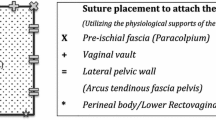Abstract
The purpose of this study was to assess the effect on quality of life and prolapse severity of traditional anterior repair compared to anterior repair with a small intestine submucosa (SIS) graft. This report was designed as a case-control study. The sample of this study consisted of 14 women who underwent traditional anterior repair and 14 women who underwent anterior repair with SIS graft (SG) at a London teaching hospital. All women were assessed preoperatively and at 6 and 24 months postoperatively using a validated prolapse quality of life questionnaire and pelvic organ quantification system (POP-Q). Quality-of-life outcomes included the following: (1) General health perception, (2) Prolapse impact, (3) Role limitations, (4) Physical limitations, (5) Social limitations, (6) Personal relationships, (7) Emotions, (8) Sleep/Energy, and (9) Severity measures. The pelvic organ quantification measurement measured nine specific points relating to the anterior and posterior wall of the vagina, vaginal apex, genital hiatus (GH) and perineal body (PB). At 6-month follow-up, the SG repair group showed significant improvement in all quality-of-life parameters measured. In comparison to traditional repair, it was significantly better in improving role limitations, physical limitations and emotions. Both operations significantly improved prolapse quality-of-life severity measures. SG repair improved all POP-Q measurements significantly, except total vaginal length (TVL), whereas traditional repair improved some measurements (AA, midline point of anterior vaginal wall 3 cm proximal to the external urethral meatus; BA, most distal dependant position of the anterior vaginal wall from the vaginal vault or anterior fornix to AA; C, most distal/dependant edge of cervix or vault; AP, point on midline posterior vaginal wall 3 cm proximal to hymenal ring; BP, most distal/dependant point on the posterior vaginal wall from vault or posterior fornix to AP) but not others (location of posterior fornix (D), TVL, GH and PB). At 2-year follow-up, there was no significant difference between the two groups in terms of quality-of-life outcomes or prolapse severity measurements. Surgery for vaginal prolapse results in marked improvement in quality of life and prolapse severity. The greater improvement seen initially in the SG anterior group was not seen at 2-year follow-up.
Similar content being viewed by others
References
Beck RP (1983) Pelvic relaxation prolapse. In: Kase NG, Weingold AB (eds) Principles and practice of clinical gynecology. Wiley, New York, pp 677–685
Olsen AL, Smith VJ, Bergstrom JO, Colling JC, Clark AL (1997) Epidemiology of surgically managed pelvic organ prolapsed and urinary incontinence. Obstet Gynecol 89:501–506
Julian TM (1996) The efficacy of marlex mesh in the repair of severe, recurrent vaginal prolapse of the anterior midvaginal wall. Am J Obstet Gynecol 175:1472–1475
Amid PK, Lichenstein IL (1997) Current assessment of Lichenstein tension-free hernia repair. Chirurg 68:959–964 (in German)
Chiu CC, Welch L (1985) Characterisation of morphological and mechanical properties of surgical mesh fabrics. J Biomed Mater Res 19:903–916
Brun JL, Bordenave L, Lefebrve F et al. (1992) Physical and biological characteristics of the main biomaterials used in pelvic surgery. Biomed Mater Eng 2:203–225
Badylak SF, Lantz G, Coffey A, Geddes LA (1989) Small intestinal submucosa as a large diameter vascular graft in the dog. J Surg Res 47:74–80
Prevel CD, Eppley BL, Summerlin DJ, Jackson JR, McCarty M, Badylak SF (1995) Small intestinal submcosa: utilisation for repair of rodent abdominal wall defects. Ann Plast Surg 35:374–380
Clarke KM, Lantz GC, Salisbury SK, Badylak SF, Hiles MC, Voytik SL (1996) Intestinal submucosa and polypropylene mesh for abdominal repair in dogs. J Surg Res 60:107–114
Parmamenter MD (2000) Healing of patients with chronic or severe diabetic wounds using an ECM-based dressing. Proc Third SIS Symposium, Orlando, FL, November 2000
Badylak SF (1993) Small intestine submucosa (SIS): a biometric conducive to smart tissue remodelling. In: Bell E (ed) Tissue engineering: current perspectives. Burkhauser Publishers, Cambridge, MA, pp 179–189
Clemens JQ, Delancey JO, Faerber GJ et al. (2000) Urinary tract erosions after synthetic pubovaginal slings; diagnosis and management strategy. Urology 56:589–595
Digesu GA, Khullar V, Cardozo L, Robinson D, Salvatore S (2005) P-QOL: a validated questionnaire to assess the symptoms and quality of life of women with urogenital prolapse. Int Urogynecol J Pelvic Floor Dysfunct 16(3):176–181
Bump R, Mattiason A, Bo K et al (1996) The standardisation of terminology of female pelvic organ prolapse and pelvic floor dysfunction. Am J Obstet Gynecol 175:10–17
Laborda E, Monga A (2003) The safety and efficacy of SIS mesh in women with recurrent prolapse. Int Urogynecol J 14(Suppl 1):S1–S81 [Abstract 100(426)]
Jackson SR, Avery NC, Tarlton JF et al (1996) Changes in metabolism of collagen in genitourinary prolapse. Lancet 347:1658–1661
Makinen J, Soderstrom KO, Kiilhoma P, Hirvonen T (1986) Histological changes in the vaginal connective tissue of patients with and without uterine prolapse. Arch Gynecol 239:17–20
Norton P, Boyd C, Deak S (1992) Collagen synthesis in women with genital prolapse or stress urinary incontinence. Neurourol Urodyn 11:300–301
Author information
Authors and Affiliations
Corresponding author
Rights and permissions
About this article
Cite this article
Chaliha, C., Khalid, U., Campagna, L. et al. SIS graft for anterior vaginal wall prolapse repair—a case-controlled study. Int Urogynecol J 17, 492–497 (2006). https://doi.org/10.1007/s00192-005-0053-y
Received:
Accepted:
Published:
Issue Date:
DOI: https://doi.org/10.1007/s00192-005-0053-y



